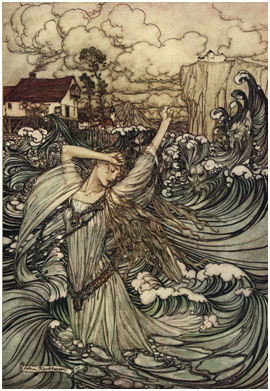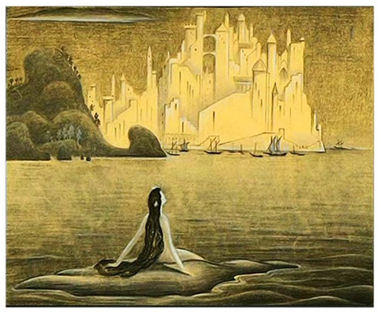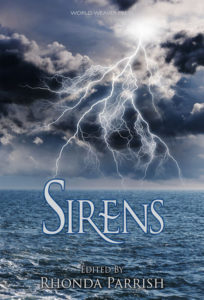Of Sirens and Sorrow – Part 2
Amanda Kespohl
ONDINE / UNDINE

Undines are a magical race of water spirits popularized by the novella, Undine, by Friederich de La Motte-Fouqué in 1811.[1] In that tale, a knight named Sir Huldbrand meets a beautiful, mischievous maiden named Undine while he is lost in a spooky enchanted forest. He is so smitten with her after a short time in her company that he decides to marry her.
After their wedding, Undine confesses her secret—she comes from a magical race of water spirits who live beneath the sea. They are fair and powerful, but lack an immortal soul, which they can only obtain by marrying a human. Undine’s father wanted his child to have one, so he sent her to live among mortals. Her uncle, Kuhleborn, the spirit of a nearby brook, used his magic to shepherd the knight and a priest into the forest to further the plan. Although Huldbrand is taken aback by this tale, he believes her. Since their marriage, he’s found her much changed from a whimsical, silly girl into a sincere and loving wife. Together, they return to the city he was visiting before his misadventure in the forest.
For a time, all is wonderful—for everyone except Bertalda, Huldbrand’s lady love, who has been waiting for him back in the city. When she finds that he’s married someone else, she does what any good noblewoman would do—she becomes Undine’s frenemy. Suspecting nothing, Undine accepts her friendship. Despite attempts by Kuhleborn to warn her, she decides to invite Bertalda back to Sir Huldbrand’s castle. Huldbrand and Bertalda immediately begin an affair.
Thereafter, Kuhleborn tries to punish the knight for mistreating Undine, but Undine uses her magic to block him at every turn. She still loves Huldbrand, though he’s often cruel to her now, and she won’t let her uncle hurt him. To keep Kuhleborn from coming into the castle, she seals up the fountain in the courtyard with a spelled stone and warns Huldbrand never to remove it. She also warns him never to reproach her while they’re near water, because her kin will take it amiss and she’ll be dragged back down to live in the depths.
As you might have guessed, Huldbrand doesn’t listen. One day as they’re sailing down the Danube River, he chastises Undine for conjuring Bertalda a gift, calling her a witch. Undine is snatched away into the water, and Huldbrand is very sorry . . . for a while. Then he gets over it and decides to marry Bertalda.
He receives a multitude of warnings that this is a terrible idea—the priest who married him to Undine tells him so, and Undine even sends him dreams in which he overhears her speaking to Kuhleborn. In the dreams, her uncle gloats over the fact that the laws of their people will require her to kill Huldbrand if he marries another. Undine reminds Kuhleborn that she won’t be able to enter the castle as long as the spelled stone blocks the fountain. Upon waking, Huldbrand presses forward with the wedding plans, undeterred.
After the wedding ceremony, Bertalda laments her lack of access to the waters in the courtyard fountain, which brightened her complexion so. Overhearing, an industrious maid sends workers out to uncover it. Out comes Undine, who kills her husband with a kiss, and Bertalda is a widow within hours of becoming a wife. At Huldbrand’s funeral, Undine becomes a spring, encircling her husband’s grave.
Little gems lie hidden throughout this tale. For instance, Undine’s name comes from the Latin word for “wave,” while Huldbrand’s name was modeled after that of the famous German hero, Hildebrand, mixed with a syllable to indicate “grace” or “favor.”[2] Kuhleborn, appropriately enough, means “cool fountain.”[3] Unfortunately, unlike the “cool fountain,” Huldbrand had zero chill, and his temper and his illicit passions brought about his ruin.
THE LITTLE MERMAID

Hans Christian Andersen’s tale, “The Little Mermaid,” by far the most familiar story on this list. It tells the story of a little mermaid who rescues a handsome prince from drowning, but is scared away before he awakens by a group of women coming down to the shore.[4] Afterwards, she learns that the only means for her people to gain an immortal soul is through marriage to a human. So enamored is she of the prince and the notion of having a soul that she makes a bargain with a sea witch to shed her tail in favor of human legs.
The price she pays is steep—every step she takes on her new legs brings a pain like being cut by knives. She can never return to the ocean, and if the prince marries another, the morning after his wedding day, she’ll dissolve into sea foam. Preparation for the draught of transformation also requires the sea witch to cut out her tongue. When she finally meets her prince again, she is mute and wracked with pain.
The prince treats her with great affection, but he views her as a child, and not a partner. He confides to her that the only woman in the world he believes he could love is the young woman who discovered him on the beach after the shipwreck. When his parents send him to meet a foreign princess, it turns out that the princess is the woman who found him on the beach. The prince enthusiastically agrees to marry her.
The prince and princess marry, and there’s a celebration aboard the prince’s ship. After the festivities, the heartbroken mermaid is alone on the deck when her sisters appear in the water. They’ve traded their long tresses to the sea witch in return for a knife. If the little mermaid uses it to kill the prince, when his blood washes over her feet, she’ll be a mermaid again. She takes the knife into the prince’s bedroom to do as she was bidden. When she looks down on him, sweetly sleeping in the arms of his beloved, she can’t do it. As the sun rises, she casts the knife into the sea and dissolves into sea foam.
Only, she doesn’t die. Instead, she becomes an air elemental with the ability to earn an immortal soul by performing 300 years of good deeds. When the prince and his bride come out on the deck to search for her, she kisses the bride, fans sweet air over the prince, and soars joyfully into the sky.
The author of this enchanting tale, Hans Christian Andersen, was inspired by folklore, although his own tales were original.[5] As a child, he used to accompany his grandmother to the insane asylum where she worked to listen to the old women in the spinning room tell stories.[6] Using the notions in those tales as a starting point and relying on his own creativity for the rest, he ultimately wrote 210 fairytales that are still wildly popular today.[7]
Amanda Kespohl is an appellate judicial clerk who writes bench summaries by day and fantasy novels and short stories by night. She lives in Tallahassee, Florida with her beagle, Bailey, and spends her spare time reading fairy tale retellings and Marvel comic books. Check out her website at https://amandakespohl.wordpress.com/ or find her on Twitter at @amandakespohl.

Reserve Your Copy Now!
[1] This section is based upon a reading of the novella, which available for free through ibooks or through Project Gutenberg.
[2] Blume, David. Telling Tales: The Impact of Germany on Children’s Books 1790-1918. Cambridge: Open Book, 2009. Available at http://books.openedition.org/obp/607?lang=en. ¶ 6.
[3] Ibid.
[4] This section is based upon the annotated version of the story featured on Sur La Lune’s web site: http://surlalunefairytales.com/littlemermaid/index.html.
[5] Windling, Terri. “Hans Christian Andersen: Father of the Modern Fairy Tale.” Journal of Mythic Arts. The Endicott Studio. 2003. http://www.endicott-studio.com/articleslist/hans-christ.html.
[6] Ibid.
[7] Ibid. at 2.

